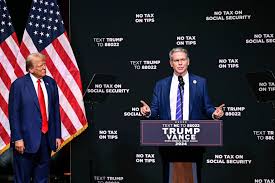
The next BOJ policy rate decision is approaching and, of course, much speculation surrounds it. I will not join the crowd because regardless of what happens next, it won’t change Japan’s fate in the medium to long term, as I have already discussed in these articles:
- 22 March 2024: WHY A HISTORICAL $JPY CURRENCY CRISIS IS AT THE DOORSTEP OF #JAPAN
- 24 April 2024: THE JPY (COUNTERINTUITIVE) DOOM LOOP – THE MORE JPY LOSES VALUE, THE MORE LEVERAGE IS FORCED TO COME OFFLINE, THE MORE THE JPY LOSES VALUE
- 25 June 2024: A PEEK INTO THE FUTURE: USD/JPY ROAD TO 300
- 2 August 2024: A TRAVELER GUIDE TO NAVIGATE THE BANK OF JAPAN MESS
The BOJ decision will only have a short-term impact, and if you believe the Trump administration is simply waiting idly for whatever comes, I have a bridge to sell you. The new US Treasury Secretary Scott Bessent stands in stark contrast to Janet Yellen, who only gained private sector experience through paid speeches to banks and hedge funds – an obvious payback for her support during her years at the FED. Notably, Bessent was a key member of Soros’ trading team that broke the Bank of England in 1992, triggering the British Pound’s collapse and securing $1 billion in profits. He understands that economic theories and central bank maneuvers work only until they don’t – you cannot perpetually distort a system that will inevitably break under specific conditions. Consequently, I’m certain he recognizes the risk to global financial stability posed by a JPY carry trade collapse – it’s not a question of if, but when. You can be sure he’s already had several conversations with BOJ and Japan’s FINMIN officials, followed by coordination calls with the FED and US Treasury. So what should we expect?
First and foremost, the USD/JPY exchange rate carries more weight than the Japanese government bond interest rate. Why? Because the ripple effect of higher interest rates is much slower than a significant shift in exchange rates. Let me illustrate with a simple example: If you borrowed 100m USD equivalent in JPY with a 10-year duration to invest in a USD-denominated asset, when rates move from 1% to 2%, the fair value of this loan decreases from 100 to 91.18. However, the borrower will still pay 1% interest for 10 years in JPY. Conversely, if the JPY strengthens from 156 to 140, the USD interest payment costs rise from $1m to $1.1m annually, and the loan repayment at maturity theoretically increases to $110m. This immediately impacts the borrower’s USD-denominated liability fair value, which is why many hedge this risk with currency swaps that would trigger a $10m present value transfer from the broker to the borrower. With trillions of USD equivalent in similar structures, brokers would simultaneously owe their clients billions in USD payments – inevitably triggering a major liquidity crisis in the global financial system. Conversely, if the JPY weakens 10% against the USD, borrowers who hedged the FX risk must post 10m USD equivalent in JPY to their brokers, triggering selling pressure on their USD-denominated assets. Clearly, excessive JPY movement creates systemic liquidity problems either way, as demonstrated on August 5th, 2024 when the BOJ’s aggressive currency market intervention to strengthen the JPY backfired. However, gradual FX rate changes allow counterparties more time to rebalance positions without fire-selling assets (mostly illiquid ones like MBS or CLOs) that can mature at par, assuming no default events permanently impair their values. At this point, it should be evident that Bessent’s goal will be to minimize JPY volatility as much as possible.
The impact of higher interest rates will begin to surface when JPY carry trades need refinancing. At that point, if the borrower has invested in assets that have significantly lost value, they’ll have to either refinance at higher rates or book substantial losses. JPY carry trades against US Treasuries are relatively “safe” since US Government default is highly unlikely (such an event would be catastrophic). As long as these borrowers can hold until maturity without liquidity pressure, things are “manageable.” However, the situation differs when the invested asset carries significant credit risk, the JPY carry trade’s value at expiry is severely impaired, and the recovery rate won’t offset principal losses. MBS, CMBS, CLOs, Private Equity funds, and stocks all fall into this category. This explains why Bessent will do everything possible to prevent a credit event, especially since these assets often serve as collateral for JPY carry trade hedging derivatives. Will he succeed? It will certainly be challenging, given the economic and market conditions inherited from the Biden administration (HOW THE BIDEN ADMINISTRATION SET UP MINE FIELDS ALL OVER THE US ECONOMY TO UNDERMINE THE FUTURE GOVERNMENT IN CASE THEY LOSE ELECTIONS).
Scott Bessent is clearly no fool, and he recognizes that a reckoning is inevitable for those who heavily leveraged themselves through JPY carry trades and now hold assets unlikely to recover their full investment value, particularly in the commercial real estate sector. Logically, he will aim to strengthen the capital position of particularly exposed banks, though this proves challenging since these same institutions have direct lending exposure to troubled sectors like commercial real estate. He has little choice but to force an overall system deleveraging at this point, reducing risk exposure before losses become unavoidable.
Given that leverage and extreme speculation have driven asset price inflation in recent years, unwinding these positions will inevitably pressure risk assets, especially stocks. Will Trump support this approach, considering he has traditionally used stock market performance to measure his administration’s success? I believe he will if he can blame Biden for it. Therefore, we should prepare for a significant asset price correction during the first part of Trump’s administration, followed by market and economic recovery that he can claim credit for by the end of his term. Scott Bessent is ideally suited to orchestrate this transition while avoiding a liquidity crisis that could trigger another Global Financial Crisis – a scenario that would likely prevent market and economic recovery by the end of Trump’s second term. Given the strong US influence over Japan and its central bank, don’t be surprised if we see this process begin this week.
JustDario on X | JustDario on Instagram | JustDario on YouTube
